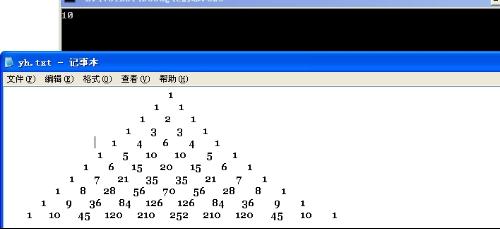UVA 568 - Just the Facts
Just the Facts
The expression N!, read as ``N factorial," denotes the product of the first N positive integers, where N is nonnegative. So, for example,
N N!
0 1
1 1
2 2
3 6
4 24
5 120
10 3628800
For this problem, you are to write a program that can compute the last non-zero digit of any factorial for (). For example, if your program is asked to compute the last nonzero digit of 5!, your program should produce ``2" because 5! = 120, and 2 is the last nonzero digit of 120.
Input
Input to the program is a series of nonnegative integers not exceeding 10000, each on its own line with no other letters, digits or spaces. For each integer N, you should read the value and compute the last nonzero digit of N!.
Output
For each integer input, the program should print exactly one line of output. Each line of output should contain the value N, right-justified in columns 1 through 5 with leading blanks, not leading zeroes. Columns 6 - 9 must contain `` -> " (space hyphen greater space). Column 10 must contain the single last non-zero digit of N!.
Sample Input
1
2
26
125
3125
9999
Sample Input
1
2
26
125
3125
9999
Sample Output
1 -> 1
2 -> 2
26 -> 4
125 -> 8
3125 -> 2
9999 -> 8
看到这个题的第一想法就是用求大数阶乘的方法求出n的阶乘,然后从最后一位开始找,直到找到一个非零的数输出。
#include<stdio.h>
#include<string.h>
int a[30000];
int main()
{
int n,i,j,c,s;
while(~scanf("%d",&n))
{
memset(a,0,sizeof(a));
a[0]=1;
for(i=2;i<=n;i++)
{
s=0;
for(j=0;j<30000;j++)
{
c=a[j]*i+s;
a[j]=c%10;
s=c/10;
}
}
for(i=0;;i++)
if(a[i])
{
printf("%5d -> %d\n",n,a[i]);
break;
}
}
return 0;
}
提交以后是Time limit exceed!
后来看了大牛的代码,才知道自己懂得太少了。下面是一种比较容易理解的代码:
include<stdio.h>
int main()
{
int n,s,i;
while(scanf("%d",&n)==1)
{
for(i=1,s=1;i<=n;i++)
{
s*=i;
while(s%10==0)
s/=10;
s=s%100000;
}
printf("%5d -> %d\n",n,s%10);
}
return 0;
}
#include<stdio.h>
int main()
{
int n,s,i;
while(scanf("%d",&n)==1)
{
for(i=1,s=1;i<=n;i++)
{
s*=i;
while(s%10==0)
s/=10;
s=s%100000;
}
printf("%5d -> %d\n",n,s%10);
}
return 0;
}
另外让大家看一下大牛们的代码:
代码一:
include<stdio.h>
int main()
{
int n,i,num;
while(scanf("%d",&n)!=EOF)
{
num=1;
for(i=1;i<=n;i++)
{
if(i%5==0)
{
int x=i;
while(x%10==0)
x/=10;
while(x%5==0)
{
x/=5;
num/=2;
}
num*=x;
}
else
num*=i;
num%=100000;/
/一定要至少保留后五位非零位(五位以上要注意int型溢出,因此取五位最佳),因为后五位非零位的进位(极限情况3125,即5^5)会影响到最后的非零位
}
printf("%5d -> %d\n",n,num%10);
}
return 0;
}
#include<stdio.h>
int main()
{
int n,i,num;
while(scanf("%d",&n)!=EOF)
{
num=1;
for(i=1;i<=n;i++)
{
if(i%5==0)
{
int x=i;
while(x%10==0)
x/=10;
while(x%5==0)
{
x/=5;
num/=2;
}
num*=x;
}
else
num*=i;
num%=100000;//一定要至少保留后五位非零位(五位以上要注意int型溢出,因此取五位最佳),因为后五位非零位的进位(极限情况3125,即5^5)会影响到最后的非零位
}
printf("%5d -> %d\n",n,num%10);
}
return 0;
}
代码二:
[ include <stdio.h>
int main()
{
int n2, n5, i, j, n, digit;
while(scanf("%d",&n)!=EOF)
{
digit = 1;
n2 = n5 = 0;
for(i=2; i<=n; i++)
{
j = i;
while(j%2 == 0)
{
n2++;
j /= 2;
}
while(j%5 == 0)
{
n5++;
j /= 5;
}
digit = (digit * j) % 10;
}
for(i=0; i<n2-n5; i++)
digit = (digit * 2) % 10;
printf("%5d -> %d\n",n,digit);
}
return 0;
}
#include <stdio.h>
int main()
{
int n2, n5, i, j, n, digit;
while(scanf("%d",&n)!=EOF)
{
digit = 1;
n2 = n5 = 0;
for(i=2; i<=n; i++)
{
j = i;
while(j%2 == 0)
{
n2++;
j /= 2;
}
while(j%5 == 0)
{
n5++;
j /= 5;
}
digit = (digit * j) % 10;
}
for(i=0; i<n2-n5; i++)
digit = (digit * 2) % 10;
printf("%5d -> %d\n",n,digit);
}
return 0;
}从2到n,每次更新digit,都先求出该数的2和5的个数,每对2和5相互抵消,每次计算都对10取模,减小计算量。显然2的个数一定比5的个数多。
补充:软件开发 , C++ ,




